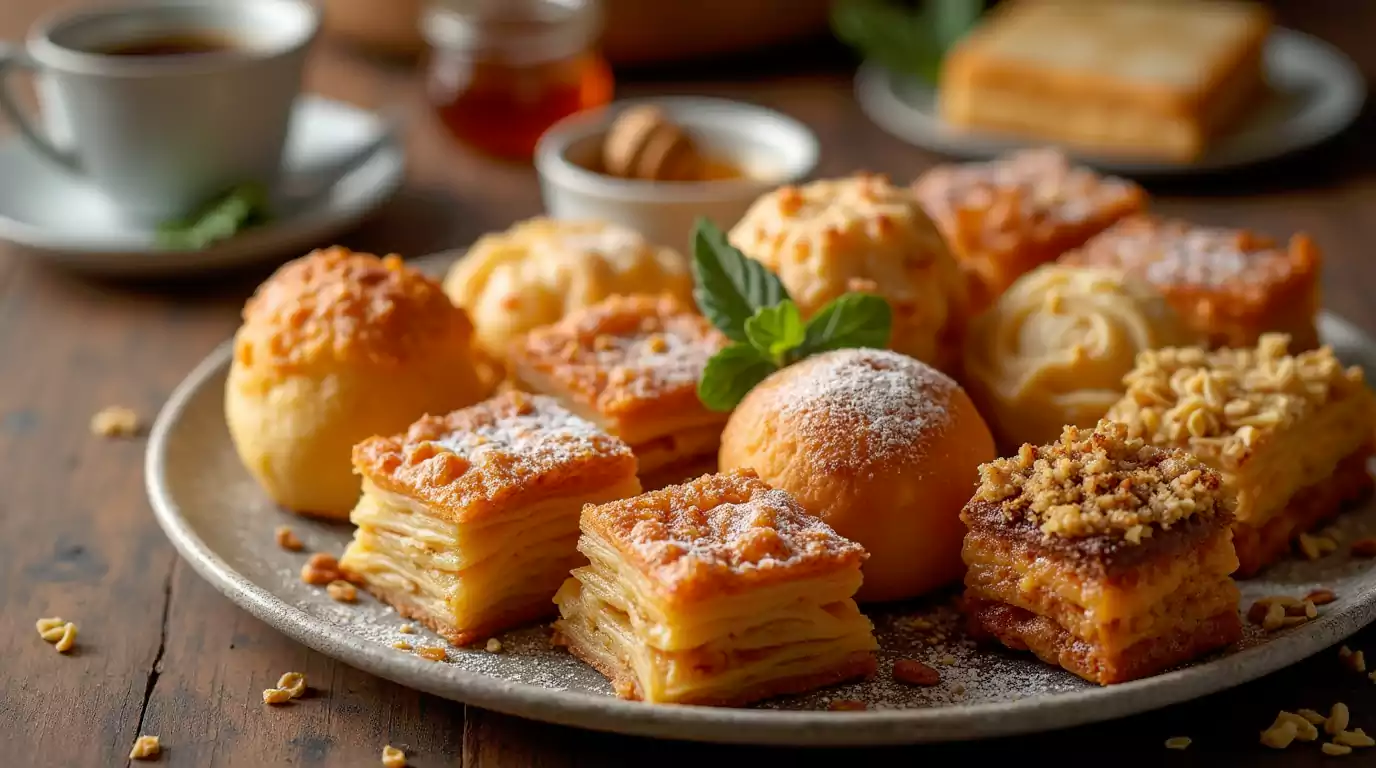Greek pastries are a delightful blend of crispy phyllo, rich custards, aromatic spices, and the signature sweetness of honey and nuts. Rooted in centuries-old traditions, these mouthwatering treats are a staple in Greek cuisine, often served during holidays, celebrations, or simply as an everyday indulgence. From the flaky layers of baklava to the airy perfection of loukoumades, each pastry tells a story of craftsmanship and cultural heritage.
In this guide, we’ll explore 10 must-try Greek pastries, their unique flavors, and why they’ve remained beloved across generations. Whether you’re a fan of buttery cookies like kourabiedes or syrup-soaked delights like kataifi, there’s something here to satisfy every sweet tooth. Ready to dive into the irresistible world of Greek sweets? Let’s get started!
1. Baklava – The Iconic Greek Pastry

Baklava is undoubtedly one of the most famous Greek pastries, enjoyed not only in Greece but across the Mediterranean, the Middle East, and beyond. This rich, nut-filled dessert is made by layering delicate, paper-thin sheets of phyllo dough with a flavorful mixture of finely chopped nuts, typically walnuts, almonds, or pistachios. Once baked to a golden perfection, it is generously soaked in a fragrant honey syrup infused with cinnamon, cloves, and sometimes a hint of lemon or orange zest.
A Bite of History
Although the origins of baklava are widely debated, it has been a staple in Greek cuisine for centuries. Some historians trace its roots back to ancient Greece, where a similar dessert known as “gastrin” was made using layers of dough, honey, and nuts. Over time, baklava evolved with influences from the Byzantine and Ottoman Empires, becoming the beloved treat it is today.
How It’s Made
Making baklava from scratch requires patience and precision. The key to its crisp and flaky texture lies in carefully layering the phyllo dough with melted butter between each sheet. The nut filling is spread between layers, ensuring a balanced bite of crunch and sweetness. After baking, the warm pastry is drenched in syrup, allowing it to absorb the flavors and achieve its signature moist yet crispy texture.
Variations of Baklava
While the classic Greek version features walnuts and honey, there are numerous regional variations:
- Some versions incorporate pistachios, giving the pastry a slightly greener hue and a nuttier taste.
- Others replace honey syrup with a sugar-based syrup, sometimes flavored with rose or orange blossom water.
- Modern twists include chocolate-drizzled baklava or versions infused with spices like cardamom and nutmeg.
Baklava is best enjoyed fresh, paired with a cup of Greek coffee or a warm herbal tea. Whether you try it at a traditional Greek bakery or make it at home, this crunchy, syrupy delight is sure to leave a lasting impression.
2. Loukoumades – Greek Honey Puffs

If you have a sweet tooth and love the idea of crispy, golden dough balls soaked in warm honey, then loukoumades are a must-try. These bite-sized Greek pastries have been enjoyed for centuries, dating back to ancient Greece, where they were reportedly served to winners of the Olympic Games as a reward for their victory. Often referred to as “Greek doughnuts,” loukoumades are crispy on the outside, soft and airy on the inside, and bursting with flavor in every bite.
How Loukoumades Are Made
The process of making loukoumades starts with a simple dough made from flour, water, yeast, and a pinch of salt. Once the dough has risen and become light and fluffy, it is deep-fried in hot oil until golden brown. The real magic happens after frying—these little puffs are immediately soaked in warm honey syrup, allowing them to absorb the sweetness while maintaining their crispiness. A sprinkle of cinnamon and chopped nuts adds an extra layer of texture and flavor.
Popular Toppings and Variations
While the classic version of loukoumades is drizzled with honey and dusted with cinnamon, there are plenty of delicious variations:
- Chocolate Loukoumades: A modern twist where the fried dough balls are drizzled with melted chocolate or stuffed with chocolate filling.
- Sesame and Nut Toppings: Some variations include crushed walnuts, almonds, or sesame seeds for a nutty crunch.
- Greek Yogurt Pairing: Some enjoy loukoumades with a side of thick Greek yogurt to balance the sweetness.
Where to Find Loukoumades
Loukoumades are a common street food in Greece and can be found at local bakeries, dessert shops, and food markets. They are especially popular during festivals and celebrations, served fresh and hot to passersby. If you’re visiting Greece, be sure to try them at a traditional loukoumades shop, where they are often made fresh to order.
Whether you enjoy them in their classic form or experiment with creative toppings, loukoumades are a true Greek pastry delight that will leave you craving more!
3. Galaktoboureko – Custard-Filled Perfection

Galaktoboureko is a classic Greek dessert that combines a silky custard filling with layers of crisp, golden-brown phyllo dough, all soaked in a fragrant syrup. This pastry is one of the most beloved Greek sweets, often served at celebrations, family gatherings, and special occasions. Its name comes from the Greek words “gala,” meaning milk, and “boureko,” referring to a pastry filled with something delicious, highlighting its rich, creamy texture.
The Perfect Balance of Creamy and Crispy
What makes galaktoboureko stand out among Greek pastries is its contrasting textures. The filling is made from a smooth, semolina-based custard, giving it a velvety consistency, while the top and bottom layers of butter-brushed phyllo dough provide a crisp bite. When baked to perfection, the golden, flaky exterior complements the soft, creamy interior beautifully.
The Secret to Its Irresistible Flavor
Galaktoboureko’s signature syrup infusion is what truly sets it apart. Once the pastry comes out of the oven, it is immediately drenched in a warm sugar syrup infused with lemon zest, cinnamon, and sometimes orange blossom water. This step ensures that every bite is packed with sweetness and aroma without making the pastry soggy. Unlike baklava, which uses honey syrup, galaktoboureko’s syrup is typically lighter and more citrusy.
How It’s Traditionally Served
In Greece, galaktoboureko is often served warm, allowing the custard to retain its soft, creamy texture while the syrup keeps the pastry moist yet crisp. Some enjoy it cold, letting the flavors intensify overnight. It is commonly garnished with a sprinkle of cinnamon or powdered sugar for an extra touch of indulgence. Pairing it with a strong cup of Greek coffee or a glass of sweet dessert wine enhances its rich flavors.
Variations and Modern Twists
Although the classic version remains the most popular, some modern variations of galaktoboureko include chocolate-filled custard for a richer flavor, mini galaktoboureko rolls that make for perfect bite-sized servings, and versions infused with orange zest or mastiha, a Greek resin known for its unique aroma. Each variation adds a new dimension to this already delicious dessert while maintaining the traditional essence of Greek pastry-making.
Galaktoboureko is a must-try for anyone who loves decadent, syrup-soaked pastries with a creamy, custard-filled center. Whether enjoyed fresh out of the oven or chilled the next day, this dessert is a true testament to Greece’s rich pastry traditions.
4. Kataifi – Shredded Phyllo Delight

Kataifi is one of the most unique and visually striking Greek pastries, known for its delicate, hair-like strands of shredded phyllo dough. Unlike traditional phyllo sheets used in baklava, kataifi dough is finely shredded, giving it a crispy, nest-like texture when baked. This distinctive dessert is filled with a rich mixture of crushed nuts, sugar, and warm spices such as cinnamon and cloves, then rolled into small logs or spirals before being baked to golden perfection.
Once out of the oven, kataifi is generously soaked in sweet honey syrup, which enhances its flavor and creates the perfect balance of crunchy and syrupy textures. The result is a pastry that’s both crisp and moist, bursting with the warm, nutty goodness that defines so many traditional Greek desserts.
Variations and Serving Suggestions
While the classic version of kataifi features a walnut or almond filling, there are several variations across Greece. Some recipes incorporate pistachios, while others add a hint of orange zest or a light drizzle of melted chocolate for an extra layer of indulgence. In some regions, kataifi is even combined with Galaktoboureko, creating a rich custard-filled variation that melts in your mouth.
Kataifi is often served as a festive treat during celebrations like Greek Orthodox Easter, Christmas, and weddings. It pairs beautifully with a cup of Greek coffee or a glass of sweet dessert wine, making it a perfect after-dinner indulgence. Whether enjoyed at a local Greek bakery or made from scratch at home, kataifi is a pastry that never fails to impress with its intricate texture and irresistible flavor.
5. More Must-Try Greek Pastries
While baklava, loukoumades, galaktoboureko, and kataifi are some of the most well-known Greek pastries, there are many other traditional desserts worth trying. Greek bakeries and homes are filled with a variety of sweets that are deeply rooted in history and often enjoyed during holidays, celebrations, and everyday life. Here are a few more must-try Greek pastries that deserve a spot on your list.
Melomakarona – Honey-Soaked Spice Cookies
Melomakarona are delicious, soft cookies made from flour, olive oil, and orange juice, then soaked in a sweet honey syrup and sprinkled with crushed walnuts. Their warm, spiced flavor, thanks to cinnamon, nutmeg, and cloves, makes them a favorite treat, especially during the Christmas season. These cookies are naturally egg-free, making them a popular choice for those observing fasting traditions.
Kourabiedes – Greek Butter Cookies
If you love rich, crumbly butter cookies, kourabiedes are a must-try. These shortbread-like cookies are made with butter, almonds, and a splash of brandy, then dusted with a generous layer of powdered sugar. They’re often associated with Christmas and weddings, symbolizing sweetness and joy. Some versions even include rose water for an extra fragrant touch.
Bougatsa – Flaky Pastry with Custard or Cheese
Bougatsa is a versatile Greek pastry that can be enjoyed as a sweet or savory dish. The sweet version features a warm, creamy custard filling wrapped in layers of crispy phyllo dough and topped with powdered sugar and cinnamon. Originating from northern Greece, particularly Thessaloniki, bougatsa is often enjoyed as a breakfast treat with a cup of Greek coffee.
Rizogalo – Greek Rice Pudding
Rizogalo, meaning rice milk in Greek, is a creamy rice pudding that combines simple ingredients like rice, milk, sugar, and vanilla to create a comforting dessert. Often topped with a sprinkle of cinnamon, this smooth and lightly sweet dish is a beloved Greek staple, served either warm or chilled. While not a pastry in the traditional sense, rizogalo is just as satisfying and widely enjoyed across Greece.
Greek pastries offer a wonderful mix of textures, flavors, and traditions, making them a true reflection of Greece’s rich culinary heritage. Whether you prefer crispy phyllo, buttery cookies, or creamy custards, there’s always a delicious Greek treat to enjoy.
Try out these Greek Pastries and let your creativity shine! We’d love to see your sweet creations. Tag us on Instagram at @SweetEatsRecipes and use the hashtag #GreekPastries to get featured.

